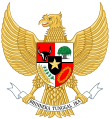1999 Indonesian presidential election
| ||||||||||||||||
|
| ||||||||||||||||
Presidential election | ||||||||||||||||
| ||||||||||||||||
700 members of the People's Consultative Assembly 351 electoral votes needed to win | ||||||||||||||||
|---|---|---|---|---|---|---|---|---|---|---|---|---|---|---|---|---|
| Turnout | 98.71% ( | |||||||||||||||
| ||||||||||||||||
 Votes of the People's Consultative Assembly
Abdurrahman Wahid: 373 votes Megawati Sukarnoputri: 313 votes
Invalid/blank votes: 5 votes Abstentions: 9 | ||||||||||||||||
| ||||||||||||||||
Vice-presidential election | ||||||||||||||||
| ||||||||||||||||
700 members of the People's Consultative Assembly 351 electoral votes needed to win | ||||||||||||||||
| Turnout | 97.86% ( | |||||||||||||||
| ||||||||||||||||
 Votes of the People's Consultative Assembly
Megawati Sukarnoputri: 396 votes Hamzah Haz: 284 votes
Invalid/blank votes: 5 votes Abstentions: 15 | ||||||||||||||||
| ||||||||||||||||
| This article is part of a series on the |
| Politics of Indonesia |
|---|
 |
From 20 to 21 October 1999, the People's Consultative Assembly (MPR), the legislative branch of Indonesia, met to elect both the president and vice president of the country for the 1999–2004 term. The incumbent president, B. J. Habibie, declined to stand for election. On 20 October, Abdurrahman Wahid, chairman of the Nahdlatul Ulama, was elected president and inaugurated on the same day. Wahid's opponent, Megawati Sukarnoputri was subsequently elected vice president the next day.[1] The elections represented the first relatively democratic and peaceful transfer of power in the history of Indonesia.[2]
Background
[edit]In October, the People's Consultative Assembly made up of the People's Representative Council and 200 nominated members from the military and selected civilians, a total of 700, met to elect the president and vice president.
There were initially four candidates for the presidency; Abdurrahman Wahid, B. J. Habibie, Megawati Sukarnoputri, and Yusril Ihza Mahendra. However, Habibie refused the nomination from Golkar after his accountability speech was rejected by the MPR the day before election, while Yusril withdrew his candidacy on election day.[3]
Election day
[edit]On 20 October, PKB chairman Abdurrahman Wahid was elected, beating Megawati Sukarnoputri by 373 votes to 313, although her party (PDI-P) won the most votes in the legislative election and had one-third of the parliamentary seats. This triggered riots among Megawati's supporters. The following day, Megawati was nominated by Gus Dur's party (PKB) as vice president and got elected, beating Hamzah Haz from the PPP by 396 votes to 284. This ended the street protests.[4][5]
This was the first and only democratically indirect presidential election in Indonesia and the first presidential election that did not feature a candidate from the ruling party (Golkar).
Results
[edit]President
[edit]| Candidate | Party | Votes | % | |
|---|---|---|---|---|
| Abdurrahman Wahid | National Awakening Party | 373 | 54.37 | |
| Megawati Sukarnoputri | Indonesian Democratic Party of Struggle | 313 | 45.63 | |
| Total | 686 | 100.00 | ||
| Valid votes | 686 | 99.28 | ||
| Invalid/blank votes | 5 | 0.72 | ||
| Total votes | 691 | 100.00 | ||
| Registered voters/turnout | 700 | 98.71 | ||
Vice president
[edit]| Candidate | Party | Votes | % | |
|---|---|---|---|---|
| Megawati Sukarnoputri | Indonesian Democratic Party of Struggle | 396 | 58.24 | |
| Hamzah Haz | United Development Party | 284 | 41.76 | |
| Total | 680 | 100.00 | ||
| Valid votes | 680 | 99.27 | ||
| Invalid/blank votes | 5 | 0.73 | ||
| Total votes | 685 | 100.00 | ||
| Registered voters/turnout | 700 | 97.86 | ||
References
[edit]- ^ "Pemilihan Presiden dari Masa ke Masa". news.Detik.com. Detik News. Oct 19, 2014. Retrieved 26 October 2021.
- ^ National Democratic Institute (28 November 1999). The 1999 Presidential Election and Post-Election Developments in Indonesia: a Post Election Assessment Report. National Democratic Institute. p. 4.
- ^ Djadja Suparman (2013). Jejak kudeta, 1997-2005 catatan harian Letnan Jenderal (Purn) TNI Djadja Suparman. Yayasan Pustaka Obor Indonesia. p. 208. ISBN 9789794618370. Retrieved 26 October 2021.
- ^ Friend, Theodore (2003) Indonesian Destinies, The Belknap Press of Harvard University Press, pp. 461–462 ISBN 978-0-6740113-7-3
- ^ Ricklefs, M.C (2008). A History of Modern Indonesia Since c. 1200 (Fourth ed.). Palgrave Macmillan. p. 539. ISBN 978-0-230-54685-1.



